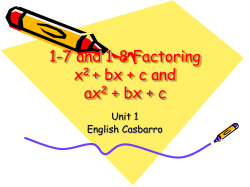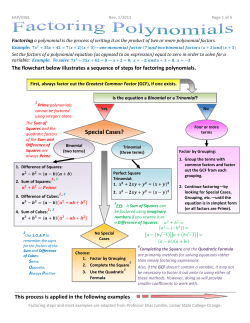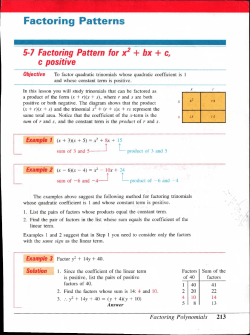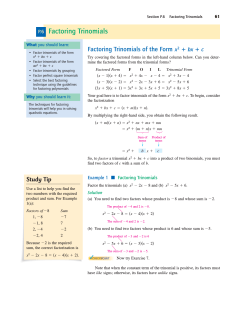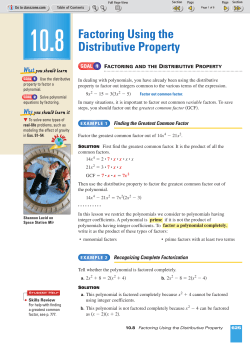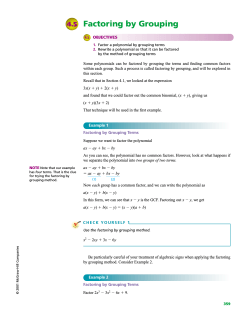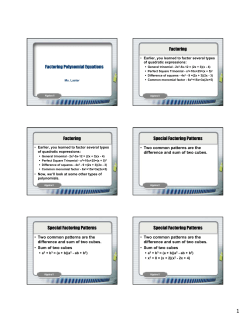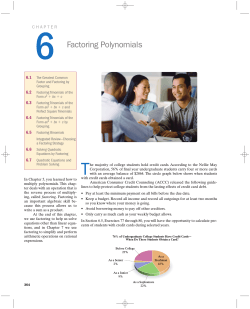
Factoring Trinomials of the Form ax bx 4.3
4.3 Factoring Trinomials of the Form ax2 bx c 4.3 OBJECTIVES 1. Factor a trinomial of the form ax2 bx c 2. Completely factor a trinomial Factoring trinomials is more time-consuming when the coefficient of the first term is not 1. Look at the following multiplication. (5x 2)(2x 3) 10x2 19x 6 Factors of 10x2 Factors of 6 Do you see the additional problem? We must consider all possible factors of the first coefficient (10 in the example) as well as those of the third term (6 in our example). There is no easy way out! You need to form all possible combinations of factors and then check the middle term until the proper pair is found. If this seems a bit like guesswork, you’re almost right. In fact some call this process factoring by trial and error. We can simplify the work a bit by reviewing the sign patterns found in Section 4.2. Rules and Properties: Sign Patterns for Factoring Trinomials NOTE Any time the leading coefficient is negative, factor out a negative one from the trinomial. This will leave one of these cases. 1. If all terms of a trinomial are positive, the signs between the terms in the binomial factors are both plus signs. 2. If the third term of the trinomial is positive and the middle term is negative, the signs between the terms in the binomial factors are both minus signs. 3. If the third term of the trinomial is negative, the signs between the terms in the binomial factors are opposite (one is and one is ). Example 1 Factoring a Trinomial Factor 3x2 14x 15. First, list the possible factors of 3, the coefficient of the first term. 313 Now list the factors of 15, the last term. © 2001 McGraw-Hill Companies 15 1 15 35 Because the signs of the trinomial are all positive, we know any factors will have the form The product of the last terms must be 15. (_x _)(_ x _) The product of the numbers in the first blanks must be 3. 341 342 CHAPTER 4 FACTORING So the following are the possible factors and the corresponding middle terms: Possible Factors Middle Terms (x 1)(3x 15) (x 15)(3x 1) (3x 3)(x 5) (3x 5)(x 3) 18x 46x 18x 14x The correct middle term NOTE Take the time to multiply the binomial factors. This habit will ensure that you have an expression equivalent to the original problem. So 3x2 14x 15 (3x 5)(x 3) CHECK YOURSELF 1 Factor. (a) 5x2 14x 8 (b) 3x2 20x 12 Example 2 Factoring a Trinomial Factor 4x2 11x 6. Because only the middle term is negative, we know the factors have the form (_x _)(_x _) Both signs are negative. Now look at the factors of the first coefficient and the last term. 414 616 22 23 This gives us the possible factors: check your work by multiplying the factors. Middle Terms (x 1)(4x 6) (x 6)(4x 1) (x 2)(4x 3) 10x 25x 11x The correct middle term Note that, in this example, we stopped as soon as the correct pair of factors was found. So 4x2 11x 6 (x 2)(4x 3) CHECK YOURSELF 2 Factor. (a) 2x2 9x 9 (b) 6x2 17x 10 Let’s factor a trinomial whose last term is negative. © 2001 McGraw-Hill Companies NOTE Again, at least mentally, Possible Factors FACTORING TRINOMIALS OF THE FORM ax2 bx C SECTION 4.3 Example 3 Factoring a Trinomial Factor 5x2 6x 8. Because the last term is negative, the factors have the form (_x _)(_x _) Consider the factors of the first coefficient and the last term. 5=15 8=18 =24 The possible factors are then Possible Factors Middle Terms (x 1)(5x 8) (x 8)(5x 1) (5x 1)(x 8) (5x 8)(x 1) (x 2)(5x 4) 3x 39x 39x 3x 6x Again we stop as soon as the correct pair of factors is found. 5x2 6x 8 (x 2)(5x 4) CHECK YOURSELF 3 Factor 4x2 5x 6. The same process is used to factor a trinomial with more than one variable. Example 4 Factoring a Trinomial Factor 6x2 7xy 10y2. The form of the factors must be © 2001 McGraw-Hill Companies The signs are opposite because the last term is negative. (_x _ y)(_ x _ y) The product of the first terms is an x2 term. The product of the second terms is a y2 term. Again look at the factors of the first and last coefficients. 616 23 10 1 10 25 343 344 CHAPTER 4 FACTORING NOTE Be certain that you have a pattern that matches up every possible pair of coefficients. Possible Factors Middle Terms (x y)(6x 10y) (x 10y)(6x y) (6x y)(x 10y) (6x 10y)(x y) (x 2y)(6x 5y) 4xy 59xy 59xy 4xy 7xy Once more, we stop as soon as the correct factors are found. 6x2 7xy 10y2 (x 2y)(6x 5y) CHECK YOURSELF 4 Factor 15x2 4xy 4y2. The next example illustrates a special kind of trinomial called a perfect square trinomial. Example 5 Factoring a Trinomial Factor 9x2 12xy 4y2. Because all terms are positive, the form of the factors must be (_x _y)(_ x _y) Consider the factors of the first and last coefficients. 991 441 33 22 Possible Factors Middle Terms (x y)(9x 4y) (x 4y)(9x y) (3x 2y)(3x 2y) 13xy 37xy 12xy So can be factored by using previous methods. Recognizing the special pattern simply saves time. 9x2 12xy 4y2 (3x 2y)(3x 2y) (3x 2y)2 Square 2(3x)(2y) Square of 3x of 2y This trinomial is the result of squaring a binomial, thus the special name of perfect square trinomial. CHECK YOURSELF 5 Factor. (a) 4x2 28x 49 (b) 16x2 40xy 25y2 © 2001 McGraw-Hill Companies NOTE Perfect square trinomials FACTORING TRINOMIALS OF THE FORM ax2 bx C SECTION 4.3 345 Before we look at our next example, let’s review one important point from Section 4.2. Recall that when you factor trinomials, you should not forget to look for a common factor as the first step. If there is a common factor, remove it and factor the remaining trinomial as before. Example 6 Factoring a Trinomial Factor 18x2 18x 4. First look for a common factor in all three terms. Here that factor is 2, so write 18x2 18x 4 2(9x2 9x 2) By our earlier methods, we can factor the remaining trinomial as NOTE If you don’t see why this 9x2 9x 2 (3x 1)(3x 2) is true, you need to use your pencil to work it out before you move on! So 18x2 18x 4 2(3x 1)(3x 2) Don’t forget the 2 that was factored out! CHECK YOURSELF 6 Factor 16x2 44x 12. Let’s look at an example in which the common factor includes a variable. Example 7 Factoring a Trinomial Factor 6x3 10x2 4x The common factor is 2x. So 6x3 10x2 4x 2x(3x2 5x 2) © 2001 McGraw-Hill Companies Because 3x2 5x 2 (3x 1)(x 2) we have NOTE Remember to include 6x3 10x2 4x 2x(3x 1)(x 2) the monomial factor. CHECK YOURSELF 7 Factor 6x3 27x2 30x. CHAPTER 4 FACTORING You have now had a chance to work with a variety of factoring techniques. Your success in factoring polynomials depends on your ability to recognize when to use which technique. Here are some guidelines to help you apply the factoring methods you have studied in this chapter. Step by Step: Step 1 Step 2 Factoring Polynomials Look for a greatest common factor other than 1. If such a factor exists, factor out the GCF. If the polynomial that remains is a trinomial, try to factor the trinomial by the trial-and-error methods of Sections 4.2 and 4.3. The following example illustrates the use of this strategy. Example 8 Factoring a Trinomial (a) Factor 5m2n 20n. First, we see that the GCF is 5n. Removing that factor gives 5m2n 20n 5n(m2 4) (b) Factor 3x3 24x2 48x. First, we see that the GCF is 3x. Factoring out 3x yields 3x3 24x2 48x 3x(x2 8x 16) 3x(x 4)(x 4) (c) Factor 8r2s 20rs2 12s3. First, the GCF is 4s, and we can write the original polynomial as 8r2s 20rs2 12s3 4s(2r2 5rs 3s2) Because the remaining polynomial is a trinomial, we can use the trial-and-error method to complete the factoring as 8r2s 20rs2 12s3 4s(2r s)(r 3s) CHECK YOURSELF 8 Factor the following polynomials. (a) 8a3 32a2b 32ab2 (b) 7x3 7x2y 42xy2 (c) 5m4 15m3 5m2 CHECK YOURSELF ANSWERS 1. (a) (5x 4)(x 2); (b) (3x 2)(x 6) 2. (a) (2x 3)(x 3); (b) (6x 5)(x 2) 3. (4x 3)(x 2) 4. (3x 2y)(5x 2y) 5. (a) (2x 7)2; (b) (4x 5y)2 6. 4(4x 1)(x 3) 7. 3x(2x 5)(x 2) 8. (a) 8a(a 2b)(a 2b); (b) 7x(x 3y)(x 2y); (c) 5m2(m2 3m 1) © 2001 McGraw-Hill Companies 346 Name 4.3 Exercises Section Date Complete each of the following statements. 1. 4x2 4x 3 (2x 1)( 2. 3w2 11w 4 (w 4)( ) ANSWERS ) 1. 3. 6a2 13a 6 (2a 3)( 4. 25y2 10y 1 (5y 1)( ) 2. ) 3. 5. 15x2 16x 4 (3x 2)( 6. 6m2 5m 4 (3m 4)( ) 4. ) 5. 6. 7. 16a2 8ab b2 (4a b)( 8. 6x2 5xy 4y2 (3x 4y)( ) ) 7. 8. 9. 4m 5mn 6n (m 2n)( 2 2 ) 10. 10p pq 3q (5p 3q)( 2 2 ) 9. 10. Factor each of the following polynomials. 11. 11. 3x 7x 2 2 12. 5y 8y 3 2 12. 13. 13. 2w2 13w 15 14. 3x2 16x 21 14. 15. 15. 5x2 16x 3 16. 2a2 7a 5 16. 17. 17. 4x2 12x 5 18. 2x2 11x 12 18. © 2001 McGraw-Hill Companies 19. 19. 3x2 5x 2 20. 4m2 23m 15 20. 21. 21. 4p2 19p 5 22. 5x2 36x 7 22. 23. 23. 6x2 19x 10 24. 6x2 7x 3 24. 347 ANSWERS 25. 25. 15x2 x 6 26. 12w2 19w 4 27. 6m2 25m 25 28. 8x2 6x 9 29. 9x2 12x 4 30. 20x2 23x 6 31. 12x2 8x 15 32. 16a2 40a 25 33. 3y2 7y 6 34. 12x2 11x 15 35. 8x2 27x 20 36. 24v2 5v 36 37. 2x2 3xy y2 38. 3x2 5xy 2y2 39. 5a2 8ab 4b2 40. 5x2 7xy 6y2 41. 9x2 4xy 5y2 42. 16x2 32xy 15y2 43. 6m2 17mn 12n2 44. 15x2 xy 6y2 45. 36a2 3ab 5b2 46. 3q2 17qr 6r2 47. x2 4xy 4y2 48. 25b2 80bc 64c2 26. 27. 28. 29. 30. 31. 32. 33. 34. 35. 36. 37. 38. 39. 40. 41. 42. 43. 44. 45. 46. 48. 348 © 2001 McGraw-Hill Companies 47. ANSWERS 49. Factor each of the following polynomials completely. 50. 49. 20x2 20x 15 50. 24x2 18x 6 51. 52. 51. 8m 12m 4 52. 14x 20x 6 2 2 53. 54. 53. 15r 21rs 6s 2 2 54. 10x 5xy 30y 2 2 55. 56. 55. 2x3 2x2 4x 56. 2y3 y2 3y 57. 58. 57. 2y4 5y3 3y2 58. 4z3 18z2 10z 59. 60. 59. 36a3 66a2 18a 60. 20n4 22n3 12n2 61. 62. 61. 9p2 30pq 21q2 62. 12x2 2xy 24y2 63. 64. 65. Factor each of the following polynomials completely. 66. 67. 63. 10(x y)2 11(x y) 6 64. 8(a b)2 14(a b) 15 68. 69. 65. 5(x 1) 15(x 1) 350 66. 3(x 1) 6(x 1) 45 67. 15 29x 48x2 68. 12 4a 21a2 69. 6x2 19x 15 70. 3s2 10s 8 © 2001 McGraw-Hill Companies 2 2 70. 349 ANSWERS a. Getting Ready for Section 4.4 [Section 3.5] b. Multiply. c. (a) (x 1)(x 1) (c) (x y)(x y) (e) (3a b)(3a b) d. e. (b) (a 7)(a 7) (d) (2x 5)(2x 5) (f) (5a 4b)(5a 4b) f. Answers © 2001 McGraw-Hill Companies 1. 2x 3 3. 3a 2 5. 5x 2 7. 4a b 9. 4m 3n 11. (3x 1)(x 2) 13. (2w 3)(w 5) 15. (5x 1)(x 3) 17. (2x 5)(2x 1) 19. (3x 1)(x 2) 21. (4p 1)( p 5) 23. (3x 2)(2x 5) 25. (5x 3)(3x 2) 27. (6m 5)(m 5) 29. (3x 2)(3x 2) 31. (6x 5)(2x 3) 33. (3y 2)(y 3) 35. (8x 5)(x 4) 37. (2x y)(x y) 39. (5a 2b)(a 2b) 41. (9x 5y)(x y) 43. (3m 4n)(2m 3n) 45. (12a 5b)(3a b) 47. (x 2y)2 49. 5(2x 3)(2x 1) 51. 4(2m 1)(m 1) 53. 3(5r 2s)(r s) 55. 2x(x 2)(x 1) 57. y2(2y 3)(y 1) 59. 6a(3a 1)(2a 3) 61. 3(p q)(3p 7q) 63. (5x 5y 2)(2x 2y 3) 65. 5(x 11)(x 6) 67. (1 3x)(15 16x) 69. (3x 5)(2x 3) a. x2 1 2 2 2 2 2 b. a 49 c. x y d. 4x 25 e. 9a b2 f. 25a2 16b2 350
© Copyright 2025

